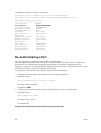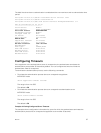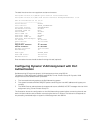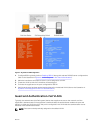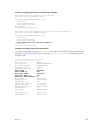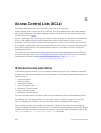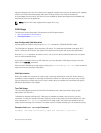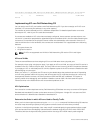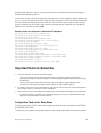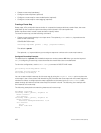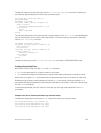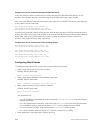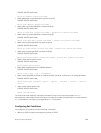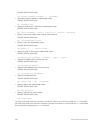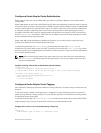
Stack-unit|Portpipe|CAM Partition|Available CAM|Estimated CAM per Port|Status
--------------------------------------------------------------------------
1| 1| IPv4Flow| 232| 0|Allowed
Dell#
Implementing ACLs on Dell Networking OS
You can assign one IP ACL per interface with Dell Networking OS. If you do not assign an IP ACL to an
interface, it is not used by the software in any other capacity.
The number of entries allowed per ACL is hardware-dependent. For detailed specification on entries
allowed per ACL, refer to your line card documentation.
If counters are enabled on ACL rules that are already configured, those counters are reset when a new
rule which is inserted or prepended or appended requires a hardware shift in the flow table. Resetting the
counters to 0 is transient as the proginal counter values are retained after a few seconds. If there is no
need to shift the flow in the hardware, the counters are not disturbed. This is applicable to the following
features:
• L2 Ingress Access list
• L2 Egress Access list
NOTE: IP ACLs are supported over VLANs in Dell Networking OS version 6.2.1.1 and higher.
ACLs and VLANs
There are some differences when assigning ACLs to a VLAN rather than a physical port.
For example, when using a single port-pipe, if you apply an ACL to a VLAN, one copy of the ACL entries is
installed in the ACL CAM on the port-pipe. The entry looks for the incoming VLAN in the packet. Whereas
if you apply an ACL on individual ports of a VLAN, separate copies of the ACL entries are installed for each
port belonging to a port-pipe.
When you use the log keyword, the CP has to log the details about the packets that match. Depending
on how many packets match the log entry and at what rate, the CP might become busy as it has to log
these packets’ details. However, the other processors (RP1 and RP2) are unaffected. This option is
typically useful when debugging some problem related to control traffic. We have used this option
numerous times in the field and have not encountered problems so far.
ACL Optimization
If an access list contains duplicate entries, Dell Networking OS deletes one entry to conserve CAM space.
Standard and extended ACLs take up the same amount of CAM space. A single ACL rule uses two CAM
entries whether it is identified as a standard or extended ACL.
Determine the Order in which ACLs are Used to Classify Traffic
When you link class-maps to queues using the service-queue command, Dell Networking OS matches
the class-maps according to queue priority (queue numbers closer to 0 have lower priorities).
As shown in the following example, class-map cmap2 is matched against ingress packets before cmap1.
ACLs acl1 and acl2 have overlapping rules because the address range 20.1.1.0/24 is within 20.0.0.0/8.
Therefore (without the keyword order), packets within the range 20.1.1.0/24 match positive against
104
Access Control Lists (ACLs)



